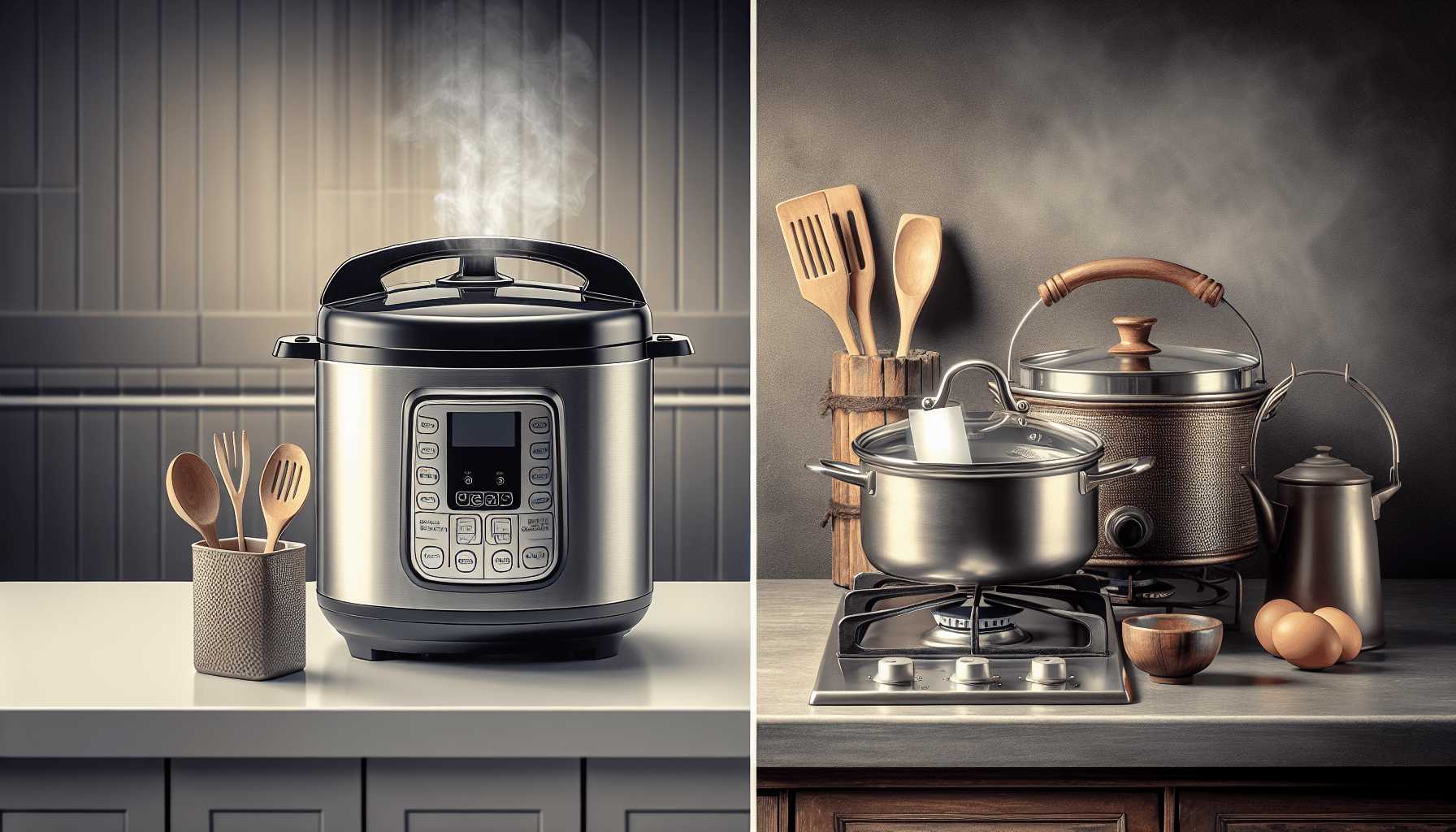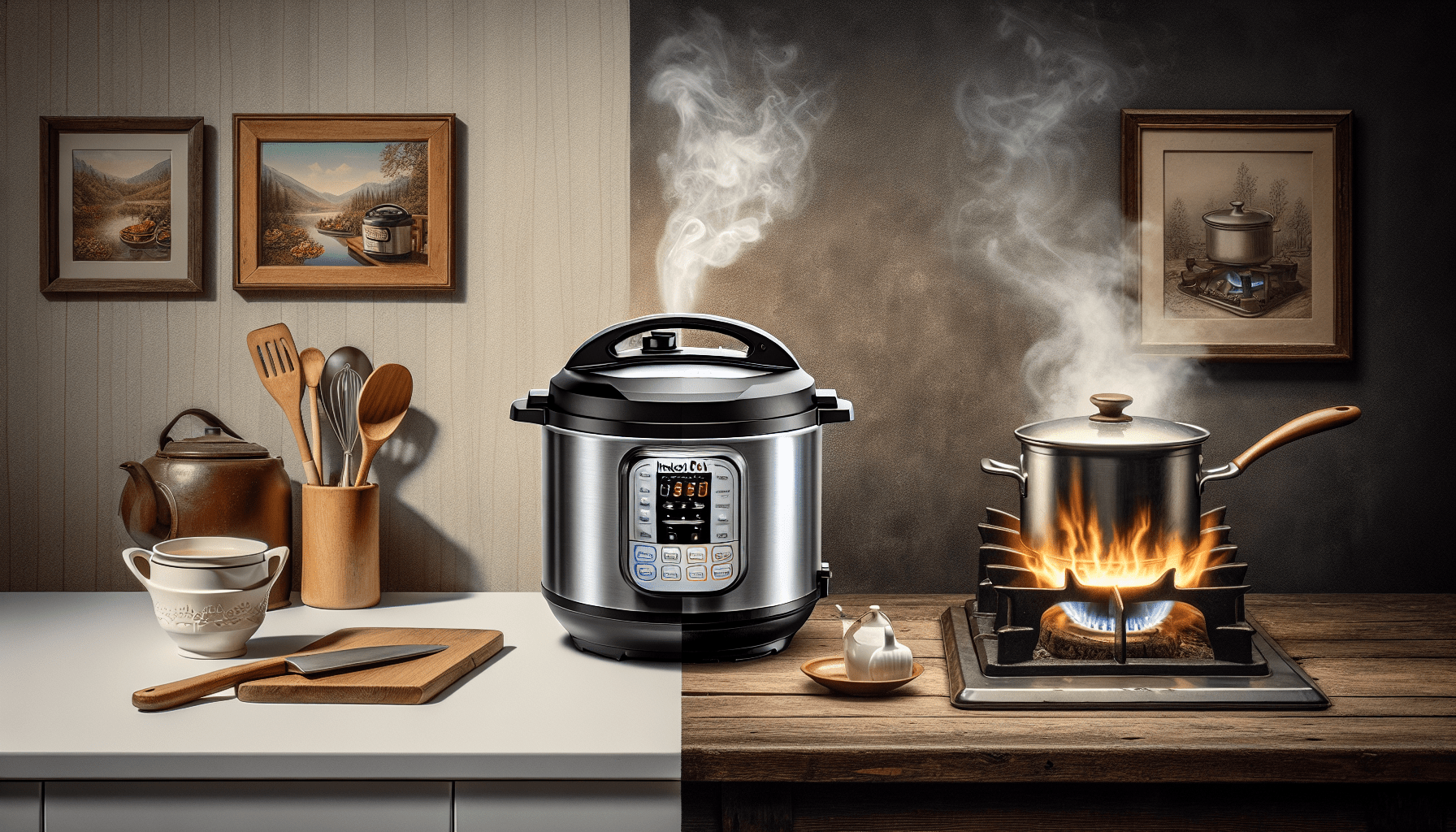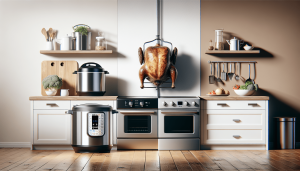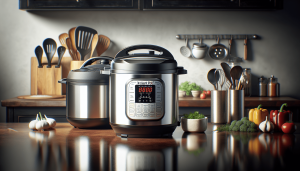Have you ever wondered which cooking method is truly better: using an Instant Pot or sticking with traditional stove cooking? It’s a question that many of us face, especially when trying to balance convenience, flavor, and time. Both methods have their loyal fans, but what’s the real deal when it comes to deciding which one to use?
Understanding the Basics
Before we compare the two methods, let’s first understand what each one entails. Knowing the tools of the trade helps us appreciate the pros and cons of each.
Instant Pot: A Modern Marvel
Instant Pots have gained popularity in recent years for good reason. This multi-functional kitchen gadget can act as a pressure cooker, slow cooker, rice cooker, steamer, sauté pan, yogurt maker, and more. By combining so many functions in one appliance, the Instant Pot saves counter space and makes cooking several types of meals very convenient.
Traditional Stove Cooking: Tried and True
Traditional stove cooking has been a staple in kitchens for decades. Whether using gas, electric, or induction stovetops, this method offers consistent heat control and versatility. From searing meat to simmering soup, traditional stoves have been our reliable kitchen companions over the years.
Time: Efficiency and Speed
Time is a critical factor when we decide how to cook our meals. Let’s examine how each method measures up in terms of speed and convenience.
Cooking Time
When it comes to speed, the Instant Pot often has the upper hand. The pressure cooking function can significantly reduce cooking times for dishes that traditionally take hours. For example, cooking a beef stew that usually takes 2-3 hours on the stove can be done in under an hour in an Instant Pot.
| Dish | Instant Pot | Traditional Stove |
|---|---|---|
| Beef Stew | 45 minutes | 2-3 hours |
| Rice | 10-12 minutes | 20-30 minutes |
| Yogurt | 8-10 hours | 8-12 hours |
Prep Time
While the Instant Pot saves cooking time, it often requires initial setup and understanding of its multiple functions. Traditional stove cooking, albeit slower, tends to be more straightforward with fewer buttons and settings to worry about. Prepping for stove cooking may mean chopping and marinating in advance, allowing the cooking process to be simpler and more familiar.

Flavor: Depth and Quality
Flavor can make or break a dish. How do these cooking methods affect the taste and texture of our meals?
Intensifying Flavors
The Instant Pot excels in intensifying flavors, thanks to its pressure cooking capabilities. The sealed environment traps flavors and moisture, creating rich and robust tastes, especially for soups and stews. The drawback, however, is that sometimes the flavors are too concentrated, which might not appeal to everyone.
Developing Flavors
Traditional stove cooking allows for better control over the development of flavors. Sautéing, simmering, and reducing liquids slowly build complex layers of taste that can be adjusted on the fly. This method gives us the ability to taste, season, and tweak dishes as they cook, making it easier to achieve the perfect flavor.
Versatility: Range of Dishes
Both the Instant Pot and traditional stove cooking offer versatility, but how do they stack up against each other in terms of the variety of dishes they can handle?
Multi-Functionality of the Instant Pot
The Instant Pot’s multiple functions mean we can prepare a wide range of dishes without needing different appliances. From the simplicity of steaming vegetables to the complexity of making yogurt, the Instant Pot caters to a vast array of culinary tasks.
Stove Top Flexibility
While traditional stove cooking doesn’t combine functionalities like the Instant Pot, it offers unmatched flexibility. Whether using a variety of pots and pans or cooking techniques like frying, boiling, and poaching, traditional stoves provide an extensive range of culinary possibilities. We can easily switch from one task to another without much hassle, making multitasking during meal prep more fluid.

Health: Nutritional Aspect
Health-conscious cooking is a priority for many of us. Let’s see how each method performs when it comes to retaining nutrients and promoting healthy eating.
Nutrient Retention in Instant Pot
The quick cooking time of the Instant Pot can help retain more nutrients in our food compared to longer cooking times. The sealed environment also minimizes nutrient loss. For instance, pressure cooking vegetables retains more vitamins and minerals than boiling them on the stove.
Health Benefits of Stove Cooking
Traditional stove cooking allows us to use less oil and fat, particularly when we utilize techniques like steaming or boiling. It also gives us the chance to control cooking temperatures, which helps in preserving the nutritional content of foods. However, longer cooking times may sometimes lead to a loss of heat-sensitive vitamins.
Safety: Which is Safer?
Kitchen safety is paramount. How do the safety features of the Instant Pot compare to those of traditional stovetop cooking?
Safety Features of Instant Pot
The Instant Pot comes with numerous built-in safety features such as pressure release valves, locking lids, and automatic shutoff, making it generally safe to use. These features are designed to prevent accidents like burns or explosions, which are common concerns with older pressure cookers.
Safety Concerns with Stove Cooking
Traditional stove cooking requires more vigilance. Open flames or hot coils can pose a risk of burns, and forgetting to turn off a burner can lead to fire hazards. However, with proper attention and care, stove cooking remains a safe option for experienced cooks.

Energy Efficiency: Sustainable Cooking
With growing awareness of our environmental impact, many of us are looking at cooking methods that are energy efficient. Which method consumes less energy?
Instant Pot Efficiency
The Instant Pot is generally more energy-efficient due to its shorter cooking times and better insulation. It uses less power compared to keeping a stove running for hours. Moreover, its multi-functionality means we can eliminate the need for multiple appliances, saving even more energy.
Stove Energy Usage
Traditional stoves, especially gas stoves, can be less energy-efficient due to the loss of heat around the cookware. Electric stoves are somewhat more efficient, particularly induction cooktops that heat cookware directly. However, the longer cooking times and multiple appliances required can add up in terms of energy consumption.
Ease of Use: User-Friendliness
How easy is it to use the Instant Pot compared to traditional stove cooking? Let’s break it down.
Learning Curve of the Instant Pot
The Instant Pot, with its numerous functions and settings, can be intimidating initially. Understanding how to properly use its different modes might take some getting used to. There’s also the need to familiarize ourselves with the pressure release mechanisms and safety features.
Simplicity of Stove Cooking
Traditional stove cooking is typically more straightforward. Most of us are already familiar with how to use a stove, adjust temperatures, and manage cooking times. There is little to no learning curve, making it accessible for everyone from novices to seasoned chefs.

Maintenance: Cleaning and Upkeep
After a delightful meal, the next task is cleanup. How do these cooking methods fare in terms of maintenance and cleanliness?
Cleaning the Instant Pot
The Instant Pot, with its detachable inner pot, is relatively easy to clean. Most parts are dishwasher safe, and the sealed environment often results in less mess compared to stovetop cooking. However, the lid and sealing ring may require extra attention to ensure they are thoroughly cleaned and free from food residue.
Maintenance of Stove and Cookware
Traditional stove cooking may involve cleaning multiple pots and pans, along with the cooktop itself. Depending on the type of stove, we might also need to clean burner grates or electric coils. Cast iron cookware, while fantastic for cooking, requires special care to maintain its seasoning and prevent rusting.
Cost: Investment vs. Savings
Let’s talk money. Is investing in an Instant Pot worth the initial cost compared to the long-term expenses of traditional stove cooking?
Initial Cost of Instant Pot
The upfront cost of an Instant Pot can be higher, especially for models with more features and larger capacities. Prices typically range from $60 to $150, depending on the model and its functionalities. However, considering it replaces several kitchen gadgets, the investment can be cost-effective in the long run.
Stove Cooking Expenses
Most of us already have a stove, so there’s no initial cost to consider. However, the long-term expenses include the cost of multiple pots and pans, as well as the ongoing cost of gas or electricity. Quality cookware can also be a significant investment, especially if we prefer non-stick or specialty items like Dutch ovens.

Sustainability: Environmental Impact
In today’s world, sustainable living is more important than ever. How do these cooking methods affect our environment?
Environmental Impact of Instant Pot
Since the Instant Pot is energy-efficient and often reduces cooking times, it has a lower overall carbon footprint compared to traditional stove cooking. Its ability to replace multiple appliances also minimizes electronic waste and the environmental impact of manufacturing various devices.
Traditional Stove Environmental Footprint
Traditional stove cooking, particularly with gas stoves, has a higher environmental impact due to higher energy consumption and carbon emissions. Electric stoves, especially those using renewable energy, offer a more sustainable option. However, the long-term use of multiple appliances and cookware also contributes to a larger environmental footprint.
Practical Scenarios
To bring it all together, let’s go through some real-life scenarios to help us decide when to use which method.
Weeknight Dinners
After a long day, we’re often looking for quick and convenient meals. The Instant Pot shines in these situations with its ability to cook one-pot meals rapidly. Dishes like pasta, rice, and stews can be prepared in under an hour, making weeknights less stressful.
Special Occasions
For special occasions where flavor, presentation, and multiple courses matter, traditional stove cooking offers more control. We can prepare dishes that require precise timing and techniques, such as searing steaks, making delicate sauces, and crafting elaborate desserts.
Meal Prep
If we’re into meal prepping for the week, the Instant Pot can make batch cooking easy. Large quantities of soups, grains, and proteins can be cooked efficiently. Conversely, stove cooking allows for more variety in flavors and textures, which can be helpful if we prefer diverse meals throughout the week.
Conclusion
Both the Instant Pot and traditional stove cooking have their unique advantages and drawbacks. The choice ultimately depends on our lifestyle, cooking needs, and priorities. For those seeking convenience, speed, and multi-functionality, the Instant Pot is an excellent addition to the kitchen. On the other hand, if we value control, versatility, and the art of traditional cooking, sticking with the stove remains a solid choice.
In the end, having both options at our disposal allows us to enjoy the best of both worlds, catering to different cooking scenarios and preferences. Whether we’re whipping up a quick meal after work or crafting a gourmet dinner for friends and family, these methods offer flexibility and fun in the kitchen.



